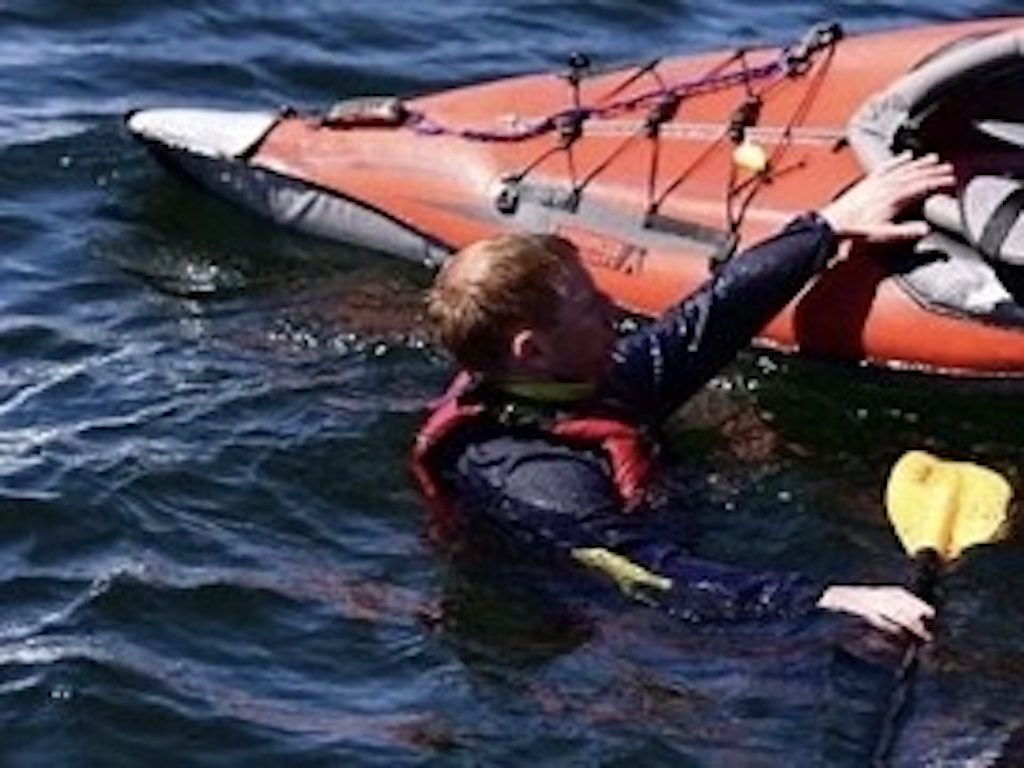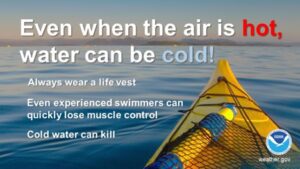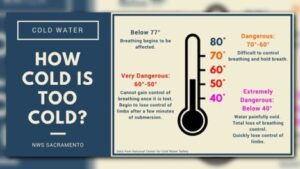Issue 7 | March 2023 | Early Season Cold Water Safety Awareness

By Bryan Gomes, ClearShark H2O Environmental Educator
While it may say March on the calendar and spring may be “in the air”, do you know what the water temperature is this time of year? On average, the water temperature in our local rivers is about 40 degrees! That is downright cold, and if you happen to go into the water (accidentally or on purpose) you will soon find this number to be true.
We all love to spend time on and around the water, and we extend our waterfront activities both later into the fall and earlier into the winter. Whether it is boating, fishing, kayaking, crabbing or just going to the water’s edge for a meal or view, we need to be aware of what the water can do to us when it is this cold.
The cold water steals our insulating abilities through conduction. Conduction is the  transfer of heat from something that is warmer (the person) to something that is colder (the water). And cold water drains our body temperature four times faster than cold air! If you ever find yourself in cold water, these guidelines from the U.S. Army Corps of Engineers may save your life.
transfer of heat from something that is warmer (the person) to something that is colder (the water). And cold water drains our body temperature four times faster than cold air! If you ever find yourself in cold water, these guidelines from the U.S. Army Corps of Engineers may save your life.
I can speak from personal experience. A few years back, I went out paddling with a friend and was exploring a neighbor’s dock. As we shifted our weight in the boat, we quickly lost balance and capsized. Plunging into the late March waters on a 60-degree day seemed like no big deal until I was totally submerged in water that was about 45 degrees. That instant shock of cold literally takes your breath away, and that is not just a saying or something you may have seen in a movie; it is the truth! This is called “cold shock” and can cause dramatic changes, not only in your breathing, but also in your heart rate and blood pressure. Going into cold water and not knowing it ahead of time is a shock to your system and a dangerous proposition. The cold water slows down your metabolism and reactions as it drains your body of necessary heat. It also begins to numb or lessen sensation and stimuli to your extremities, and the simple act of swimming a few yards to a ladder becomes a monumental task.
Another time I chose to be out in cold water, we went wakeboarding on Thanksgiving Eve. Although we were wearing wetsuits, we were not wearing booties, gloves, or hoods to protect our extremities. When I fell in the water on an attempted jump, the cold-water reaction was lessened by my wetsuit layer; but when I got to the ladder to get out of the water, my hands had gone numb, and I physically could not grab the ladder to pull myself out of the water. This was a horrible sensation that made me panic more, and I was so glad friends on the boat could reach down and pull me and my frozen hands onto the boat.
It is this loss of muscular control that becomes severe and widespread the longer you are in the cold water. This physical incapacitation can start within seconds of being in cold water. It also can happen at a slower rate in waters as warm as 77 degrees. Remember, our core body temperature is about 99 degrees so anything more than 20 degrees from our body temperature will have an impact.
This lowering of the body’s core temperature is known as hypothermia. On land, it can render a person helpless in minutes. In the water, it can happen in mere seconds. Judgment becomes clouded as motor skills decline. In the water, this can lead to drowning. The first thing to do is get yourself or the person in the water out as quickly as possible. Do not massage extremities as this can cause nerve damage, and do not give alcohol or caffeine. Replace wet clothes with warm dry clothing. Get the person to a controlled environment such as a building or car. If this is not immediately available, give them extra layers such as jackets, blankets, tarps, or whatever is available. Seek medical attention immediately with signs of hypothermia. When in doubt, call 911. A person’s core temperature can continue to drop even after being removed from cold water.
Click here for a pertinent Chesapeake Bay Magazine article about cold water paddling. Although it came out during the pandemic, it is still relevant, covers our local waters, and includes tips for cold water paddling.
There are two things you can do to increase your preparedness if you are on or around the water by yourself in the “off seasons”. One, file a float plan with someone you know. The plan should include the vessel you are on, the number and names of people on the vessel, what your communication devices are (phone or radio), and your estimated return/arrival time. The person you leave this info with should communicate with you if they don’t hear from you around the estimated return or arrival time. The other thing you can do if you are often on the water alone is to purchase a personal locator beacon, or if you are carrying a smartphone, you can share your location with your float plan person for the time you anticipate being out on the water.
When you are around the water in the non-summer season, don’t let the warm air  give you a false sense of security. If you are a cold-water boater, angler, paddler or whatever your recreation is, know before you go, have a plan, and prepare accordingly. Sometimes changing your trip plans if the weather and/or temperature are not safe is your best course of action.
give you a false sense of security. If you are a cold-water boater, angler, paddler or whatever your recreation is, know before you go, have a plan, and prepare accordingly. Sometimes changing your trip plans if the weather and/or temperature are not safe is your best course of action.

